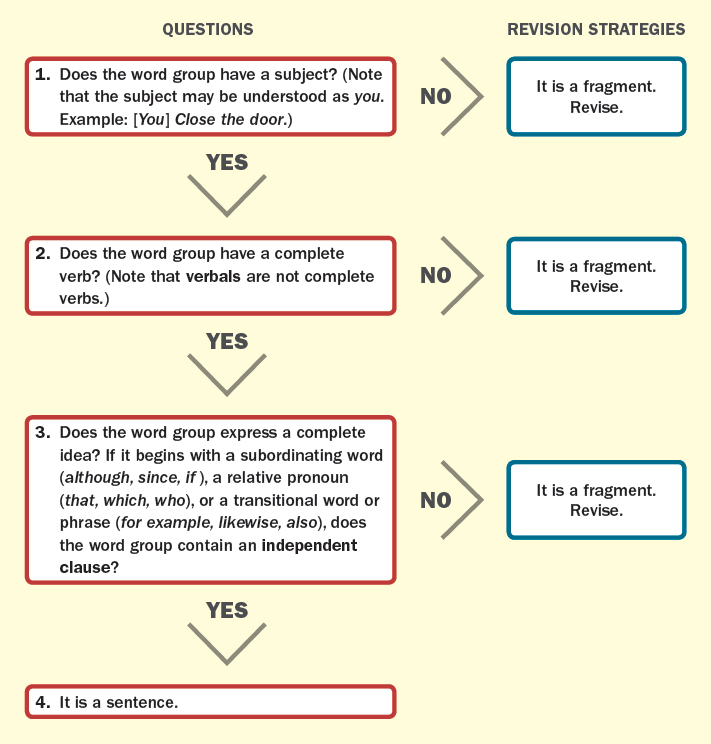3 Sentence Fragments
WRITING CORRECT SENTENCES
3
Sentence Fragments
A sentence fragment is a group of words that cannot stand alone as a complete sentence. A fragment is often missing a subject, a complete verb, or both.
FRAGMENT |
Are hatched in sand. |
This group of words does not tell who or what are hatched in sand. It lacks a subject. |
|
FRAGMENT |
Especially his rebounding ability. |
This group of words has a subject, his rebounding ability, but lacks a verb. |
|
FRAGMENT |
To notice a friendly smile. |
This group of words lacks both a subject and a verb. To notice is not a complete verb. It is an infinitive. |
 macmillanhighered.com/successfulwriting LearningCurve > Fragments
macmillanhighered.com/successfulwriting LearningCurve > Fragments

A group of words can have both a subject and a verb but still be a fragment because it does not express a complete thought.
FRAGMENT |
 |
This group of words does not tell what happened as a result of the voter decline. Its meaning is incomplete. |
Notice that the preceding fragment begins with the subordinating conjunction because. A clause that begins with a subordinating conjunction cannot stand alone as a complete sentence. (For a list of common subordinating conjunctions, see 2c.)
Word groups that begin with a relative pronoun (that, which, who) are also not complete sentences.
FRAGMENT |
 |
The group of words does not tell what the scientists studied. |
Finally, when a word group begins with a transitional word or phrase (for example, also), make sure that it includes both a subject and a verb.
FRAGMENT |
 |
Use the flowchart above to help you decide whether a particular word group is a complete sentence or a sentence fragment. Also try reading your essays backward from the end to the beginning, sentence by sentence, to check for fragments. This method allows you to evaluate each sentence in isolation, without being distracted by the flow of ideas throughout the essay. You might also try turning each sentence into a yes or no question by adding a helping verb, such as do, does, or did. A complete sentence can be turned into a yes or no question, but a fragment cannot.
SENTENCE |
Sociology has wide applications. |
YES/NO QUESTION |
Does sociology have wide applications? |
FRAGMENT |
While sociology has wide applications. |
YES/NO QUESTION |
[Cannot be formed] |
A sentence fragment can be revised in two general ways: (1) by attaching it to a nearby sentence or (2) by rewriting the fragment as a complete sentence. The method you choose depends on the element the fragment lacks as well as your intended meaning.

3a Join a fragment lacking a subject to another sentence or rewrite it as a complete sentence
Attach a fragment lacking a subject to a neighboring sentence if the two are about the same person, place, or thing.

As an alternative, you can add a subject to turn the fragment into a complete sentence.

3b Add a helping verb to a fragment lacking a complete verb
Make sure that every sentence you write contains a complete verb. For example, verb forms ending in -ing need helping verbs to make them complete. Helping verbs include forms of do, be, and have as well as such words as will, can, could, shall, should, may, might, and must. When you use an -ing verb form in a sentence without a helping verb, you create a fragment. To correct the fragment, add the helping verb.

3c Join a fragment that lacks both a subject and a verb to another sentence, or add the missing subject and verb
Often, fragments lacking a subject and verb begin with an infinitive such as to hope, to walk, and to play, which are not complete verbs, or they begin with an -ed or -ing form of a verb. Revise a fragment that begins with an infinitive or an -ed or -ing verb form by combining it with a previous sentence.

You can also revise a fragment beginning with an infinitive or an -ed or -ing verb form by adding both a subject and a verb to make it a complete sentence.

Watch out for fragments that begin with a transitional word or phrase. They can usually be corrected by joining them to a previous sentence.

3d Join a fragment beginning with a subordinating word to another sentence, or drop the subordinating word
You can correct a fragment beginning with a subordinating word by joining it to the sentence before or after it.

As an alternative, you can revise this type of fragment by dropping the subordinating word.

3e Join a fragment beginning with a relative pronoun such as who or whom to another sentence, or rewrite it as a complete sentence
Another common type of sentence fragment begins with a relative pronoun. Relative pronouns include who, whom, whose, whoever, whomever, what, whatever, which, and that.

Professional writers sometimes use sentence fragments intentionally to achieve special effects, particularly in works of fiction or articles written for popular magazines. An intentional fragment may be used to emphasize a point, answer a question, recreate a conversation, or make an exclamation. However, you should avoid using intentional fragments in academic writing. Instructors and other readers may find the fragments distracting or too informal, or they may assume you used a fragment in error.